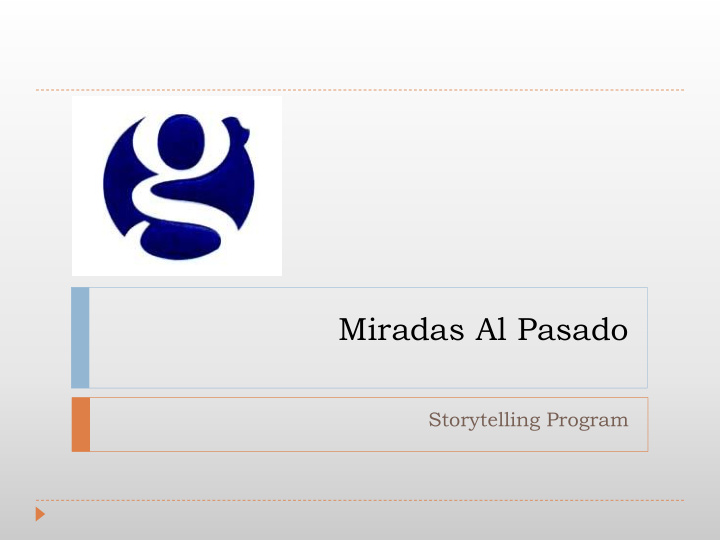



Miradas Al Pasado Storytelling Program
Introduction of Program Staff Judy De Leon, LMFT - Program Coordinator Program Supervisor- Angelica Eliazar, LCSW Mariana Lopez, Peer mentor Manuel Chavez Calderon, Peer Mentor Maricela Garcia, Peer Mentor
Outreach We have done presentations and outreach at various locations such as: IHSS Senior Housing Complexes Sourcewise Community Centers Wellness and Health Fairs We use a combination of methods to engage clients in these outreach presentations, such as psycho-education about wellness and the use of reminiscence kits. Our outreach material is in English and Spanish
Reminiscence Kits Smell Kit Audio Kit Tactile Sensory Kit Visual Kit We also use natural prompts they already have such as : Pictures Videos Songs Instruments
Challenges Finding the right kind of client Many people are interested in having such a program but don’t meet necessary criteria once scales are applied Some people have other complicating factors such as health that impact their ability to participate Some clients under report their level of distress or symptoms Lack of services after this level of support We are challenged on something that is comparable to this program, that once clients finish, can continue to somewhere that still provides support
Typical MAP client Average Age: 80 Female (71 %) Hispanic (86%) Poor English Proficiency (71%) Average years of living in the US: 40 ½ of respondents live with Family
Community Event We held 5 community Format of a typical Events Community Event is: May 30, 2013 at ADHC Showcasing of Visuals Feb 17, 2014 at St James Certificates and recognitions of participants Jan 24, 2015 Mayfair T estimonials or feedback July 22, 2015 Biblioteca about the Storytelling Latinoamericana program Dec 1, 2015 Biblioteca Food/Refreshments Latinoamericana Time to mingle with their friends, family and others
Maestros de La Vida- July 12, 2014
Peer Mentors Peer mentors are a key aspect of this program. Having a person of the clients same culture helps with them being able to relate their experiences. Feedback from Peer Mentor Visuals and narratives that have been created with the help of peer mentors.
Client testimonials “I loved the program, it is so nice to be able to hear the stories my mother told you. Who would have thought of doing this. Thank you for all the happiness and importance you gave to my mom. She loved it! Keep up the good work to get more awesome stories.” R. C. “Amazing project and presentation and great event! The art was amazing and beautiful! Maricela thank you so much for everything you have done for my grandma and thank you for giving her the canvases for her painting. The paintings were as beautiful as you! Thank you!” J. G. “This program was wonderful. It’s a great way to connect with generations that come before us. I felt honored to be here with my mother and listen to so many stories of those who are often forgotten and left to be alone.” J.M.
MAP aims to Increase protective factors Protective factor How MAP addresses to increase this area Receiving care for mental and If a client needs health or additional mental health treatment we can use CM to refer physical health problems and link them. We have referred at least 7 of our participants to more intensive mental health treatment. Social connectedness We include family members and caregivers to participate if the client so chooses. Also the community events are forums to share with others about their stories. These efforts are in hopes of connecting them with others. A sense of purpose or In reviewing their past many seniors felt as though they had lots of achievements and meaning has many successful events in their histories and thus adding to a sense of meaning or purpose. Skills in coping and adapting There wasn’t a measure for this area in the program, however of the clients who did to change the best in our program went on to find connection through a senior center or have a renewed enthusiasm for what the future holds for them still. Thus managing to cope with the changes in their lives. Cultural or religious beliefs Having a cultural peer, someone that understood their value base, was especially that discourage suicide helpful for seniors, since often it is this age group that hold on most rigidly to traditional values and norms. In being able to talk to someone who was very familiar to their background they were able to express themselves more clearly. As part of the PHQ-9, suicide was discussed. Though never an easy discussion, having a peer of the same group certainly made it easier.
Thank you for your attention Any Questions?
Recommend
More recommend